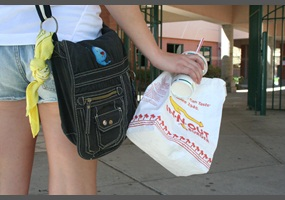
By Sierra Hobson
High school is a place where teens have the chance to learn responsibility, expand their education, and above all, grow both academically and personally. High school is also where most students begin driving. Driving is one of the biggest steps a person can take in life because it opens up a whole new horizon of opportunities including finding a job or starting a new hobby. Despite this new window of opportunity being a little dangerous and scary, it is a necessity to most.
One way to build upon the responsibility of being a young driver is to offer off-campus lunch at high schools like Batavia. This would give students the practice they need, and the freedom they desire.
Batavia has over a thousand students, most of whom are licensed and parking either in the the school’s lot, or a nearby facility.When asked about off-campus lunch senior Alyssa Klemm and sophomore Elisa Reamer weighed in on the pros and cons.
Both students agreed that off campus lunch would be a positive step in Batavia’s future. Not only would it provide students with a wider variety of food, students would be happier in general due to the alleviation of stress that a break from school could provide. However, reasons against off campus lunch are just as relevant. When students are off school grounds there is a higher risk for injury such as a car accident, and unfortunately, an easier route for students to consume alcohol.
However, The Rider Online brings up the point that, “The district sets a double standard by allowing students to drive to and from school but not allowing them to drive to lunch.” The article continues on by mentioning that not only is driving a student’s responsibility, not the schools, but, a debatable safety hazard. The likelihood of a car accident occurring on the way to lunch is just as likely on the way to and from school.
For administration, rules and regulations seem to be the top priority. However, from a student’s perspective, the benefits of this type of program are what is most important, not a list of precautions that may or may not be needed. Klemm, a two-sport athlete and active club member knows a lot about responsibility. In her opinion, off-campus lunch could be achieved if handled in the safest, and most effective way. Klemm suggests that only licensed drivers whose cars are parked on school grounds should participate making the number of participants somewhat consistent.
“Sometimes you feel a little trapped at school so off-campus lunch would provide a break from the stresses of tests, homework, and pressures of college preparation,” Klemm said. “You would be able to recuperate and get your choice of food before returning for the second half of the school day.”
Like most schools, Batavia has a long list of programs that work, and some that faculty and administration have concerns about. Off-campus lunch is an opportunity with both positive and negative consequences, all depending on the integrity and responsibility of the students it’s intended for. Whether or not off-campus lunch is ever set forth in Batavia, or any high school in the area, most can agree that in a perfect world, getting some fresh air and enjoying a meal outside of the cafeteria would be pretty incredible.